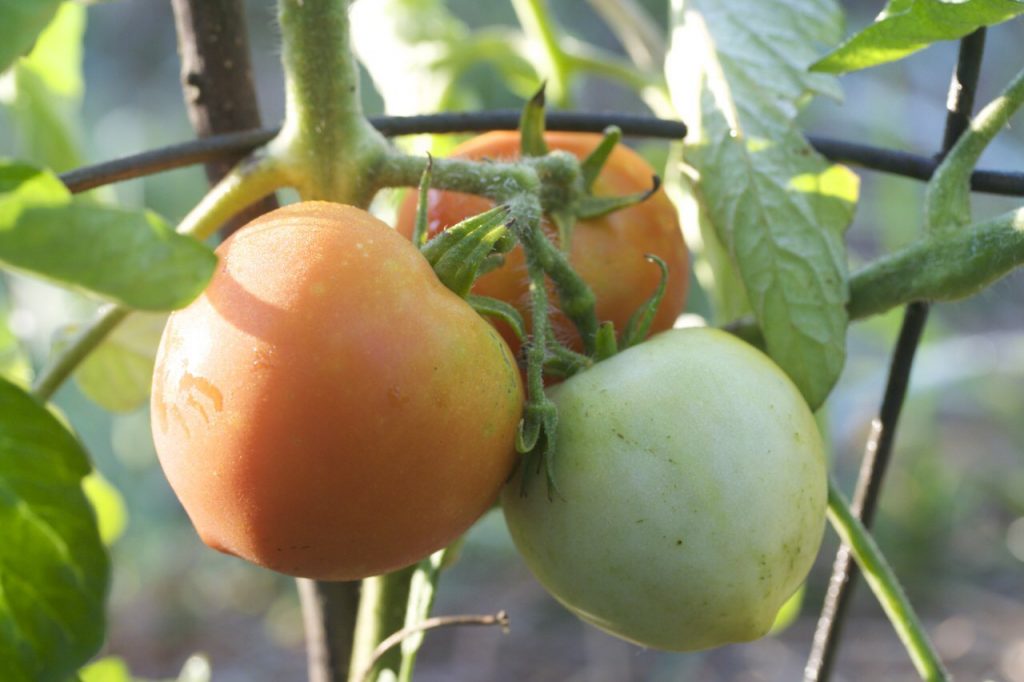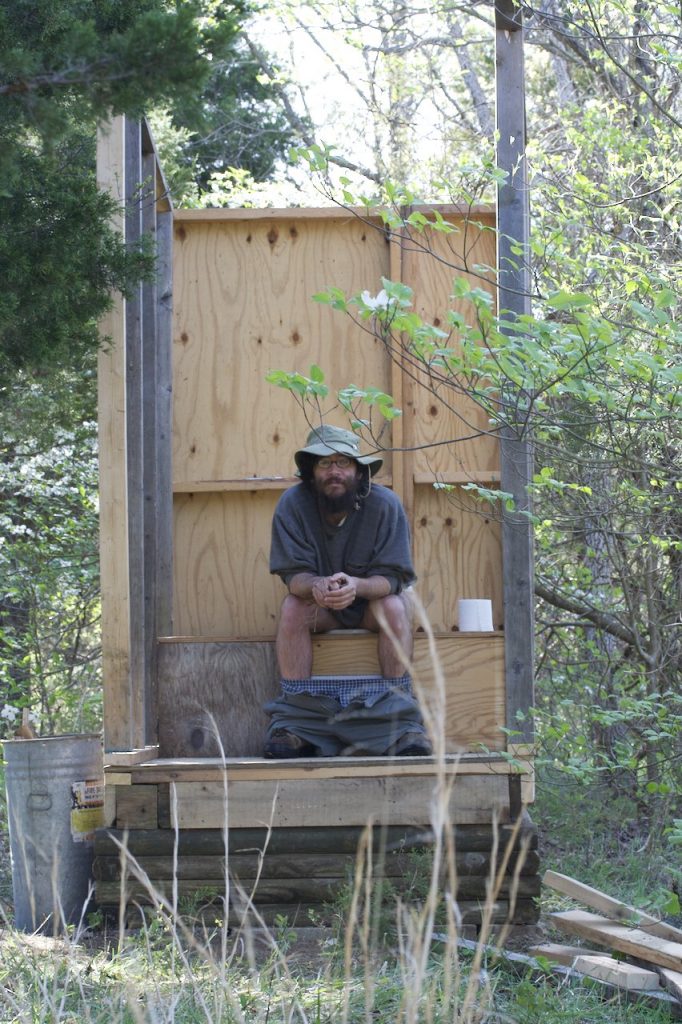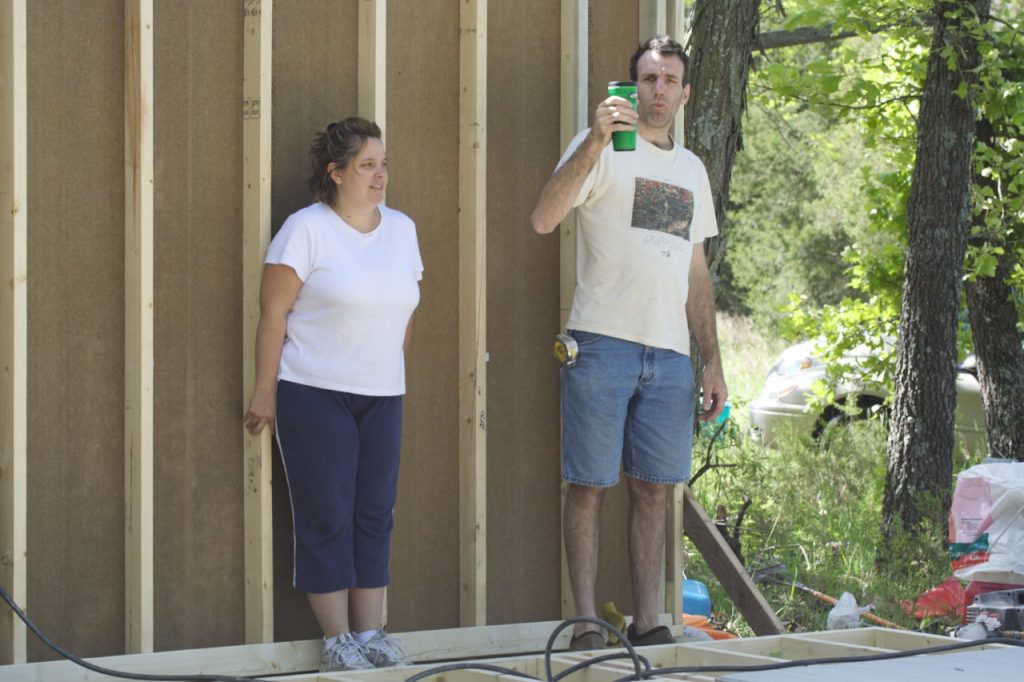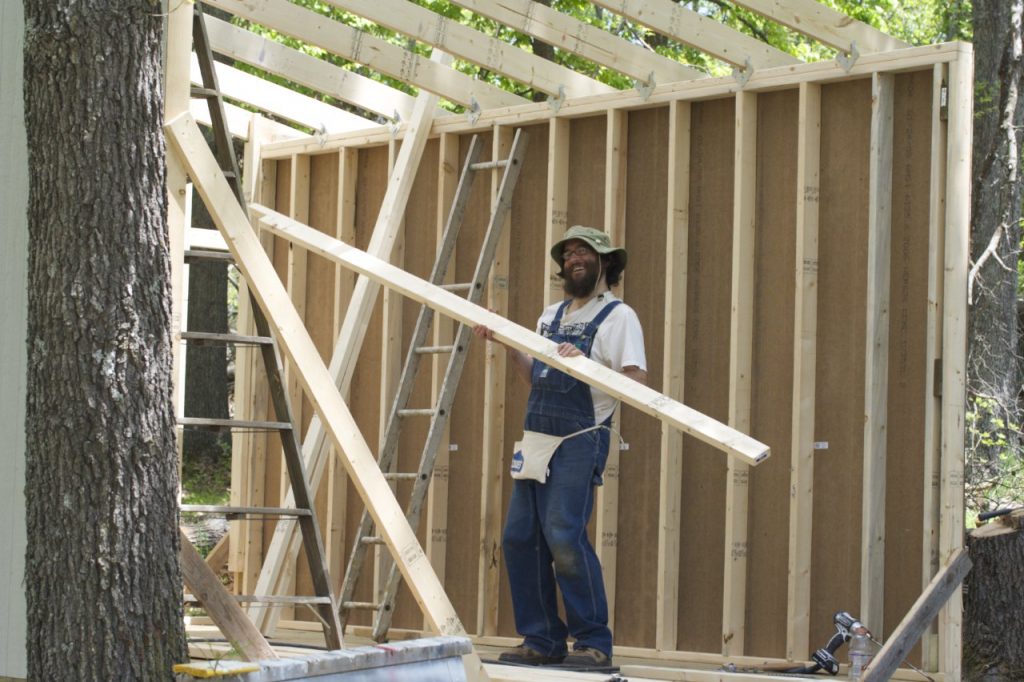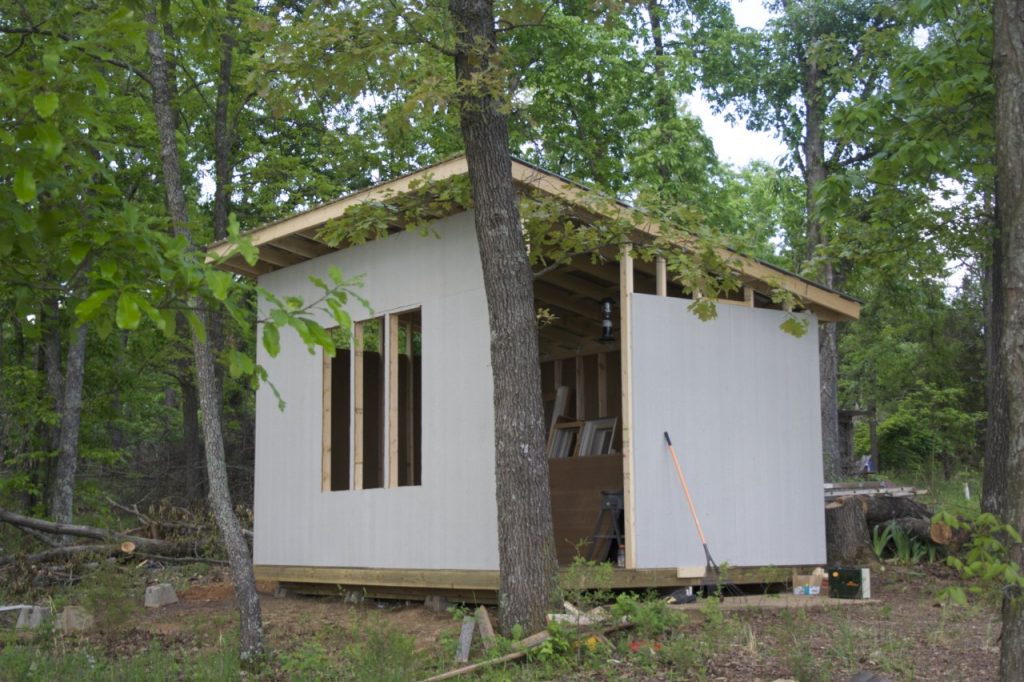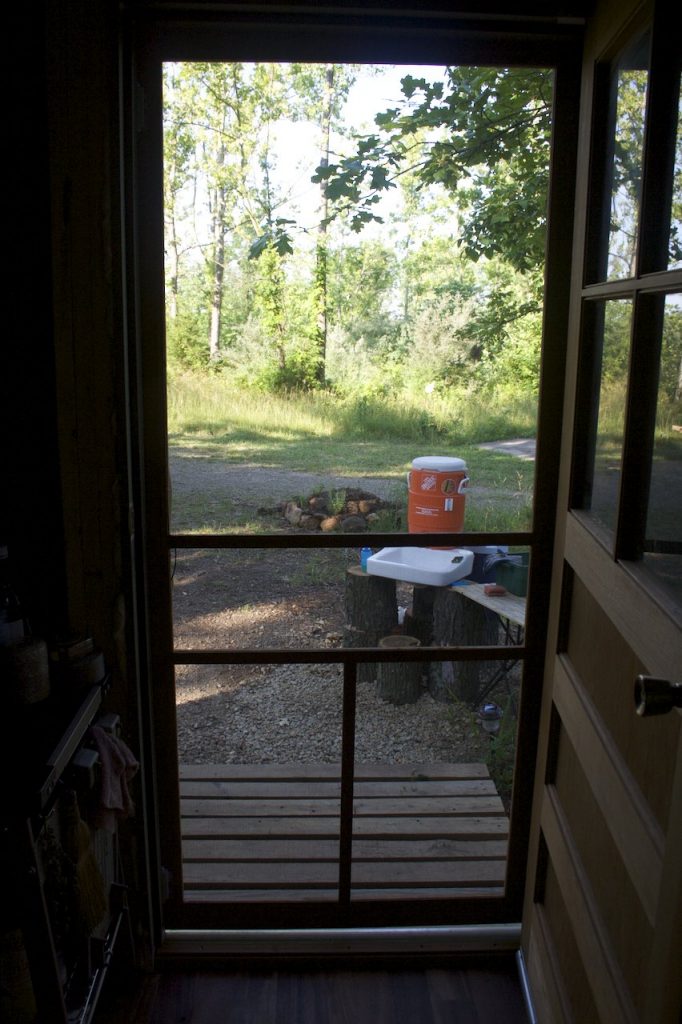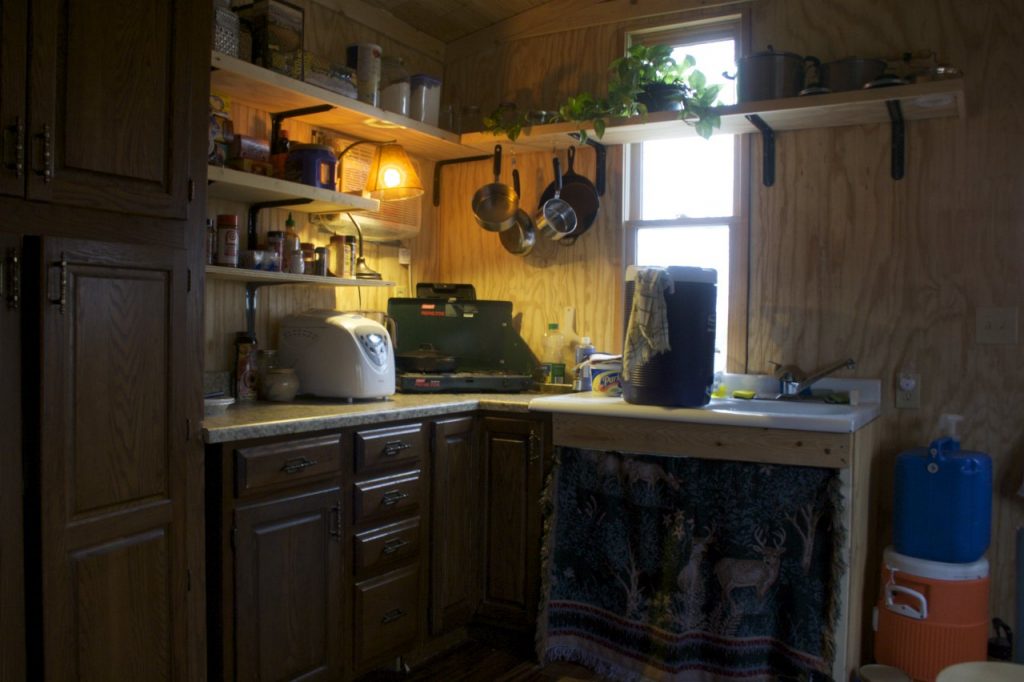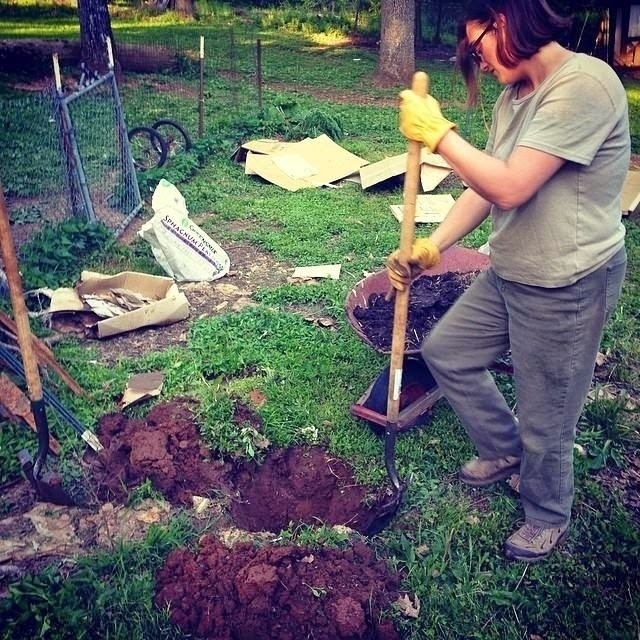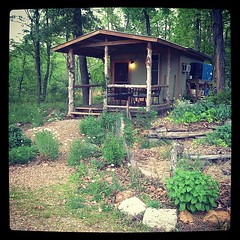Permaculture
- After 5 years in my tiny cabin I had a 2 year relationship which took away for a bit ↩︎
192 Square Feet: Part 3
Previously: Part 1, Part 2 I shared about the first year of my tiny house life. Building the tiny house, setting up the garden and food forest during the first summer. Then, of course, learning about living in the tiny house during winter and what that means for keeping warm and keeping things working.
The following spring and summer were spent extending the garden, building a chickencoop-greenhouse and raising chickens and guineas, and setting up a bee hive. Oh, and some local farmer friends brought me an orphaned fawn. We also built the kids’ cabin, the third cabin, for Kerry and Greg’s kids. A wild goose showed up mid-summer and adopted me.
The chicken coop greenhouse came first for practical reasons. I needed a place for the young chickens! The idea was to have the two attached. In theory the greenhouse would help keep the chicken coop warm in the winter and the proximity of the coop to the greenhouse also made sense in terms of composting the chicken coop straw bedding that was full of chicken poop. I could haul the straw just 25 feet to a compost pile between the greenhouse and the garden.
Then the bees which were set-up in their new hive in late April. More about beekeeping an a future post. All went as planned. Until it didn’t.
Petunia the deer came to live with me in early June after a new farmer friend. Luckily we had a safe, enclosed area for her. More photos of her in another post.
I also set up 6 rain barrels on a frame behind my cabin. Each barrel held 50 gallons and they were upside down with a PVC pipe connecting them all via the built in screw lids. This arrangement allows the barrels to all fill at the same time because they are filling from the bottom up. The photo below was taken before everything was finished so the run-off was a haphazardly arranged salvaged gutter that carried water to my swale which was mulched and planted with pawpaws and rhubarb a well a a few herbs.
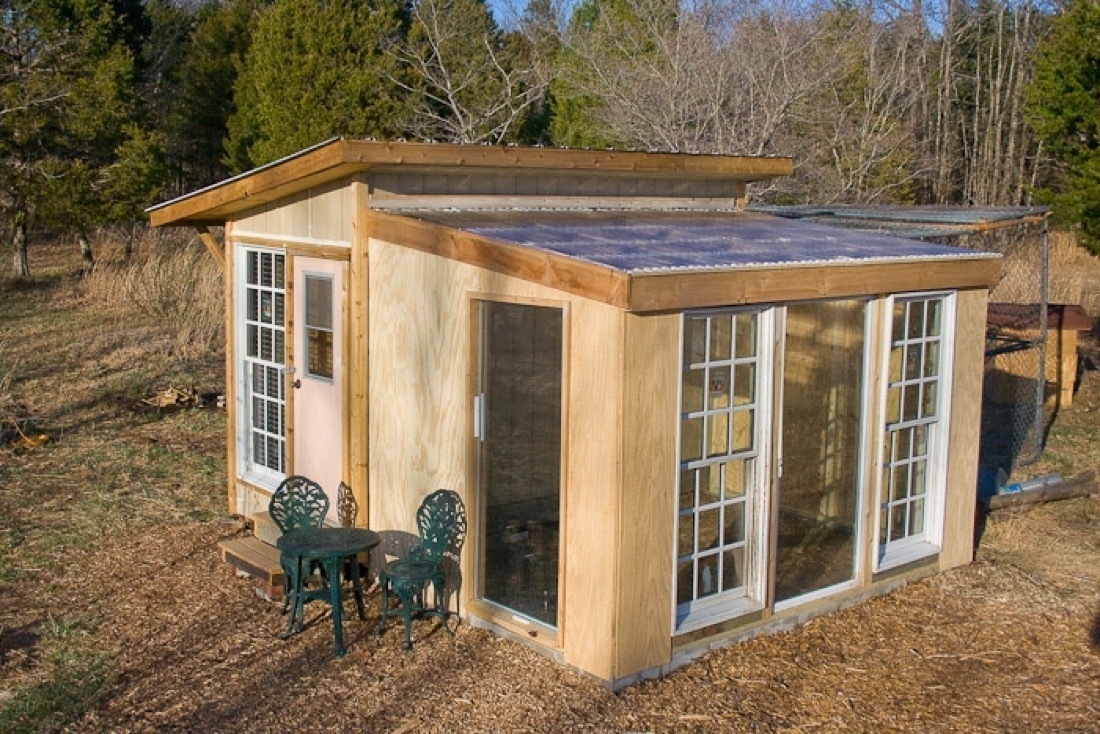 The newly finished chicken coop greenhouse.
The newly finished chicken coop greenhouse.
 Happy chickens!
Happy chickens!
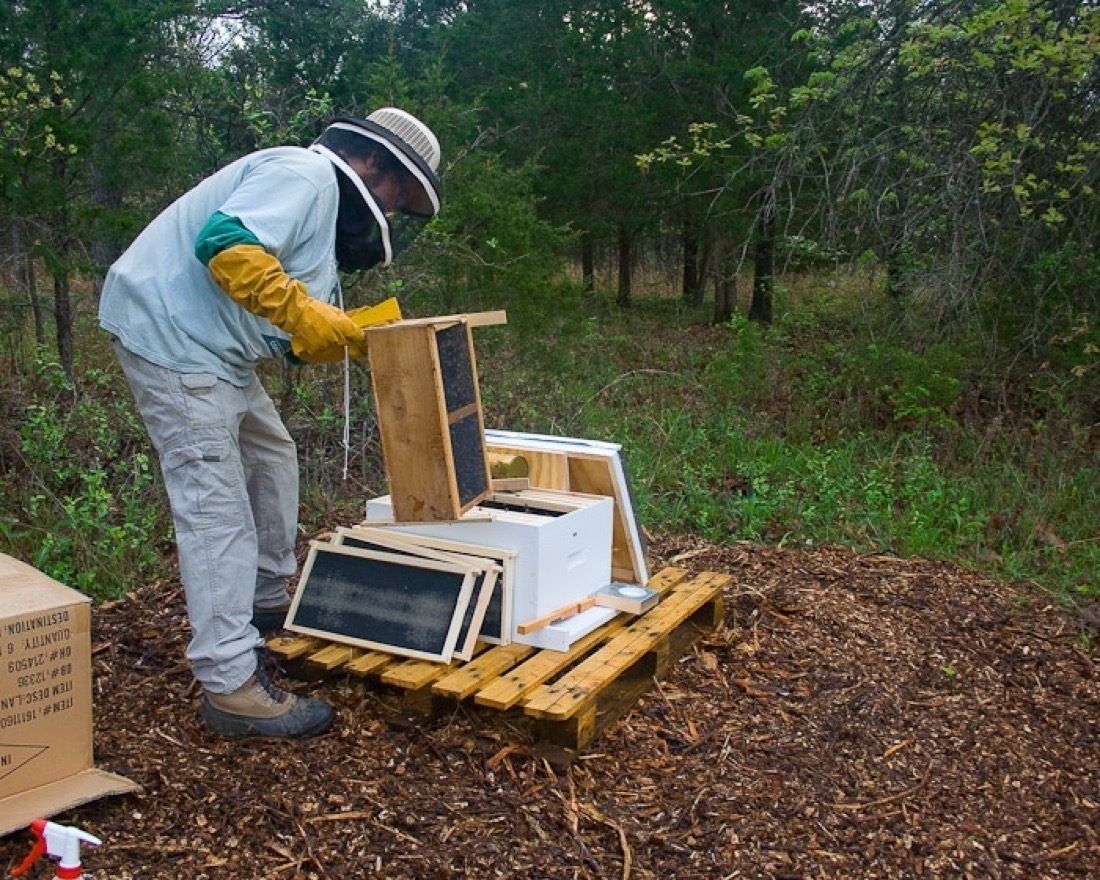 Setting up the new bees in their hive.
Setting up the new bees in their hive.
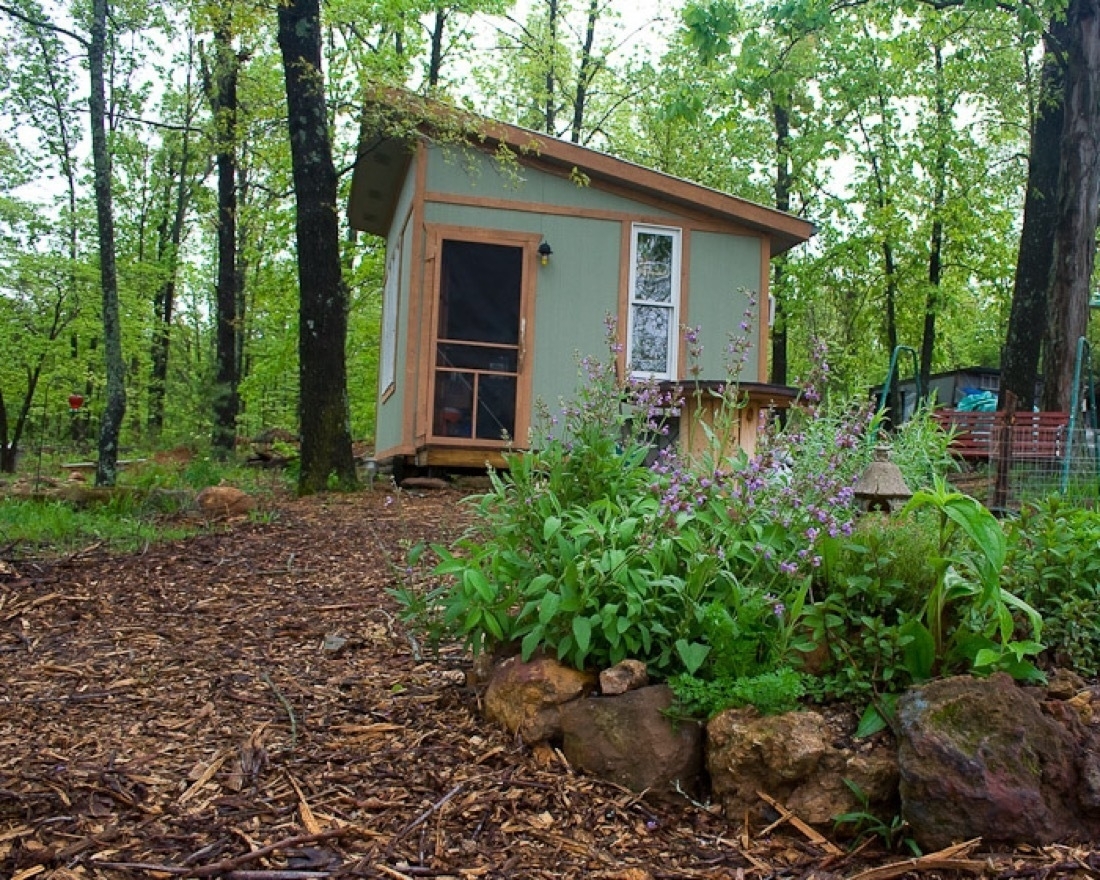 Herb spiral bed in front of my cabin.
Herb spiral bed in front of my cabin.
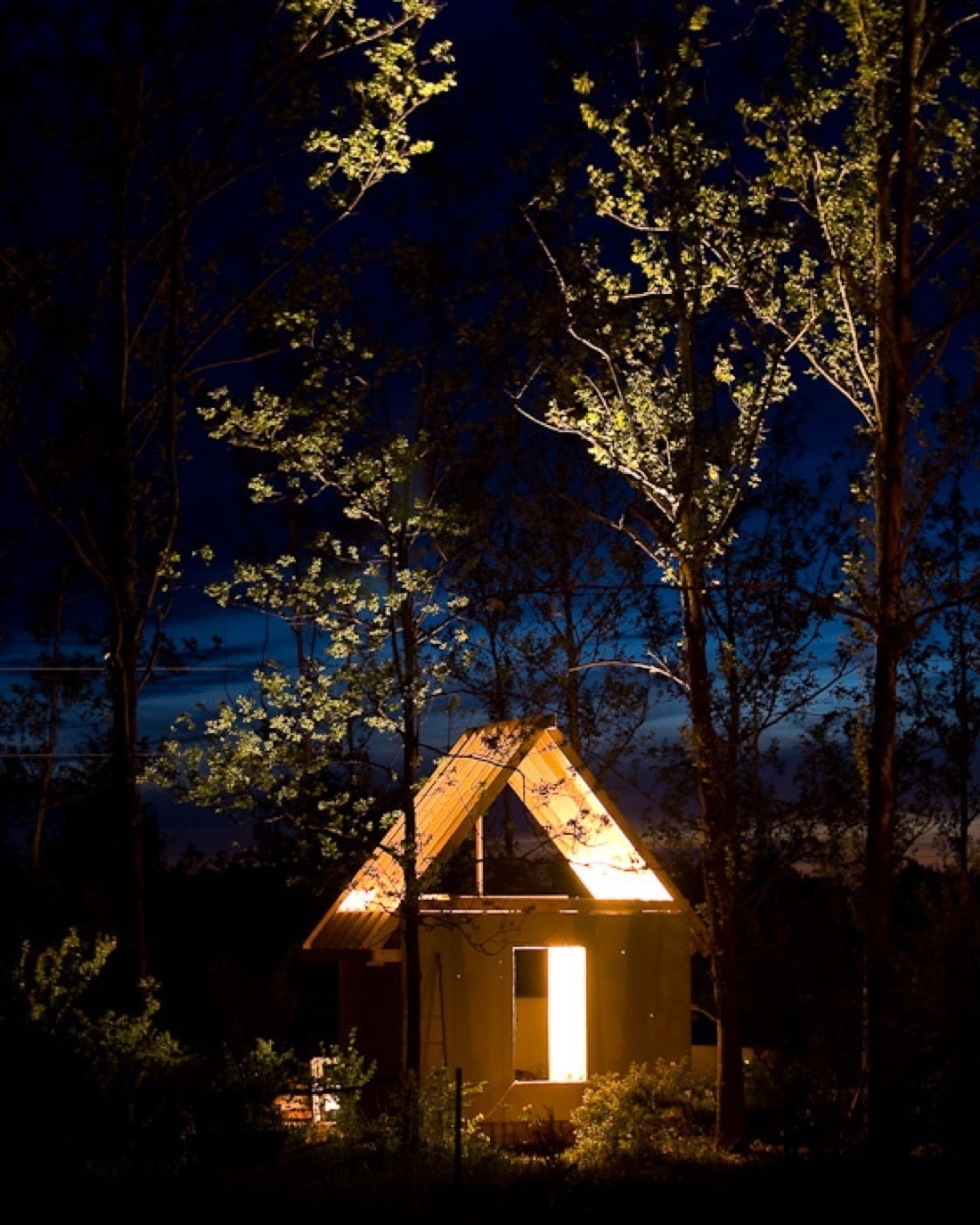 The kids’ cabin before the roof
The kids’ cabin before the roof
 Petunia moves in
Petunia moves in
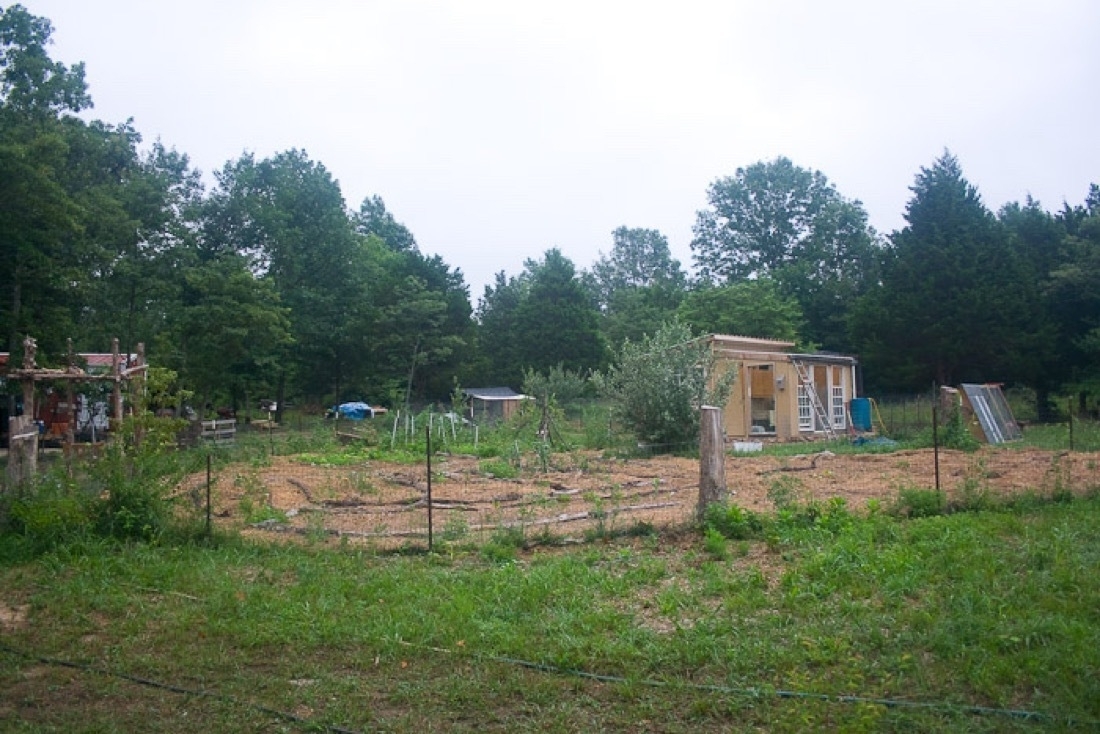 The spring kitchen garden, fully fenced in and mulched with cardboard and straw
The spring kitchen garden, fully fenced in and mulched with cardboard and straw
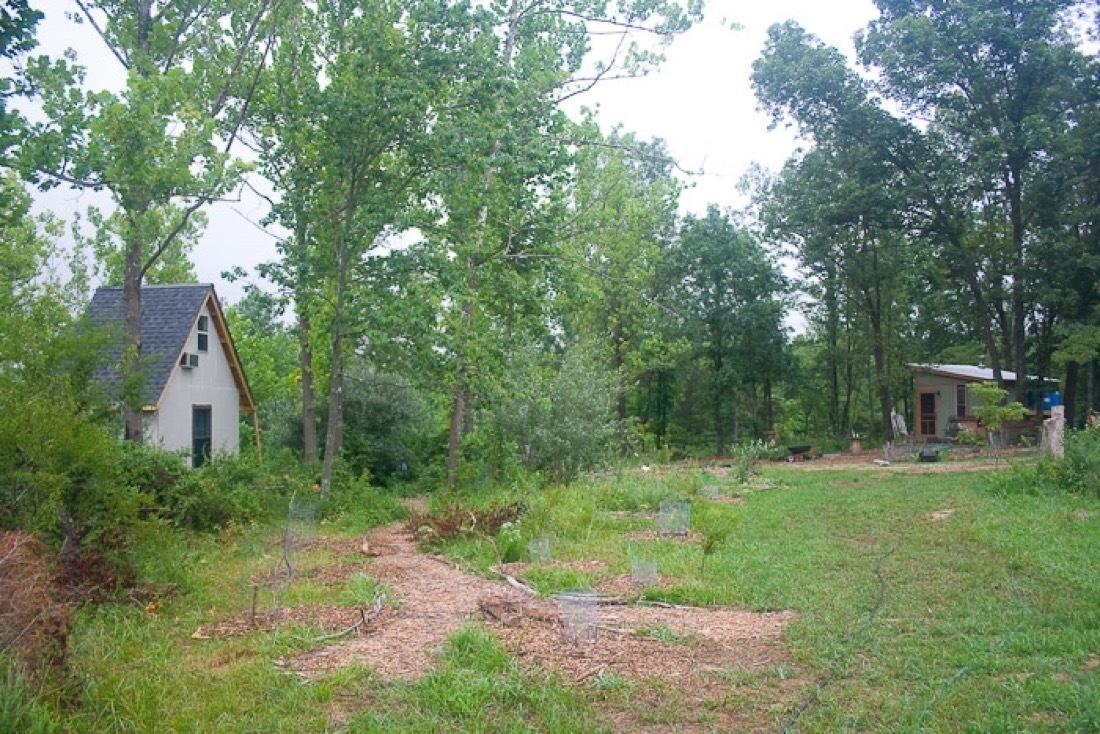 Mulched paths taking shape!
Mulched paths taking shape!
 Paths
Paths
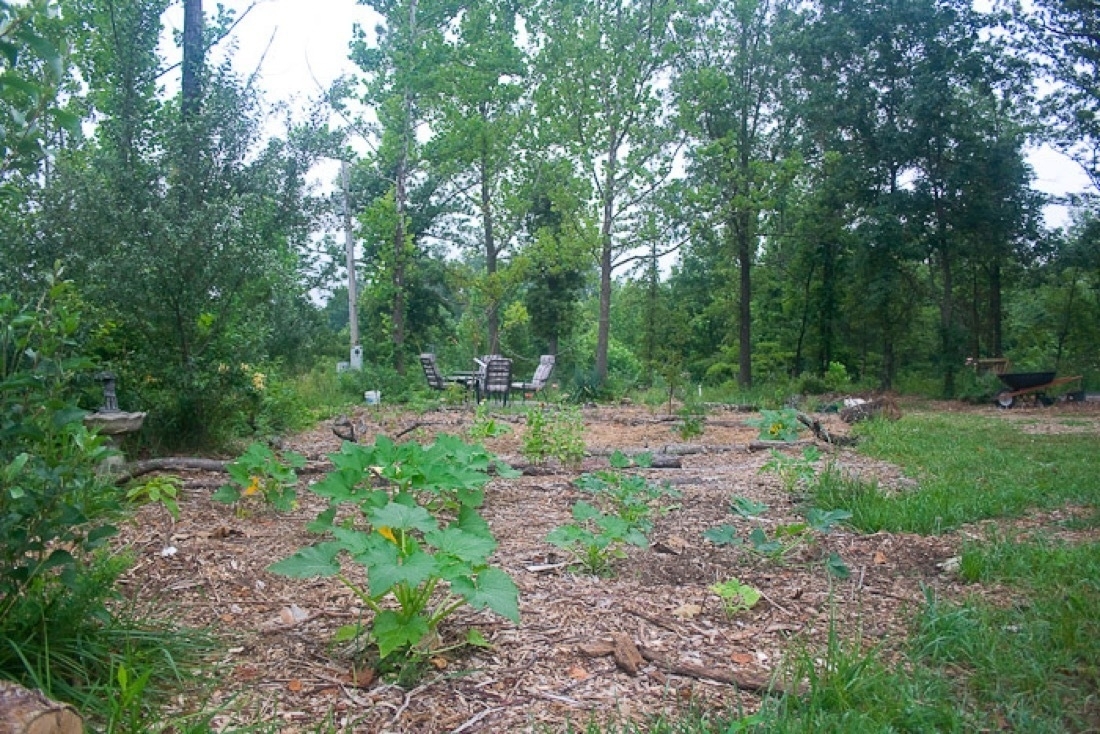 The early food forest interplanted with squash
The early food forest interplanted with squash
 The food forest in front of my cabin with a mix of peaches, plums, gooseberry, currants and comfrey. Mulch with straw between small seedlings. Paths are defined by small logs and covered in bark and wood chip mulch.
The food forest in front of my cabin with a mix of peaches, plums, gooseberry, currants and comfrey. Mulch with straw between small seedlings. Paths are defined by small logs and covered in bark and wood chip mulch.

True story: Loretta the goose showed up one day in the summer and followed me to the outhouse which is back by the chicken coop. As I’m the only one here full time I leave the outhouse door open while doing my business as it’s a nice view. Well, this goose follows me up into the outhouse (3 steps) and proceeds to turn around to face outward and sits down on my feet. I almost died right there. When it was time to go I stood up and she did the same and then she stepped out ahead of me and followed me back to my cabin. And that was that, I’d been adopted by a Canada Goose. She spent the rest of the day hanging out around my cabin and left at sunset. I didn’t know if she’d be back but hoped she would.
She was back the following morning and spent the day with me. She just hung around outside the cabin, near the little pond I’d made for the frogs. At sunset she flew away. This was the daily routine for the next couple of months. She’d follow me around as I did my chores during the day and occasionally take a dip in the pond. There were times when I’d be doing chores and there would be a line behind me: the chickens, Petunia the deer (who was now free ranging) and Loretta the goose. On at least one occasion when I had guests over for dinner outside she stayed later than normal and as we stood/sat around a little fire after eating she stayed next to me making her various adorable little utterances. It seemed to me that it was her way of being in the conversation.
In late November or early December we had a few cold nights and the lake started to freeze over. As far as I could tell she didn’t spend any time in the lake but it seemed to be a cue to her. She flew off one evening and I never saw her again. I loved her and I still miss her.
 The mostly completed kids cabin
The mostly completed kids cabin
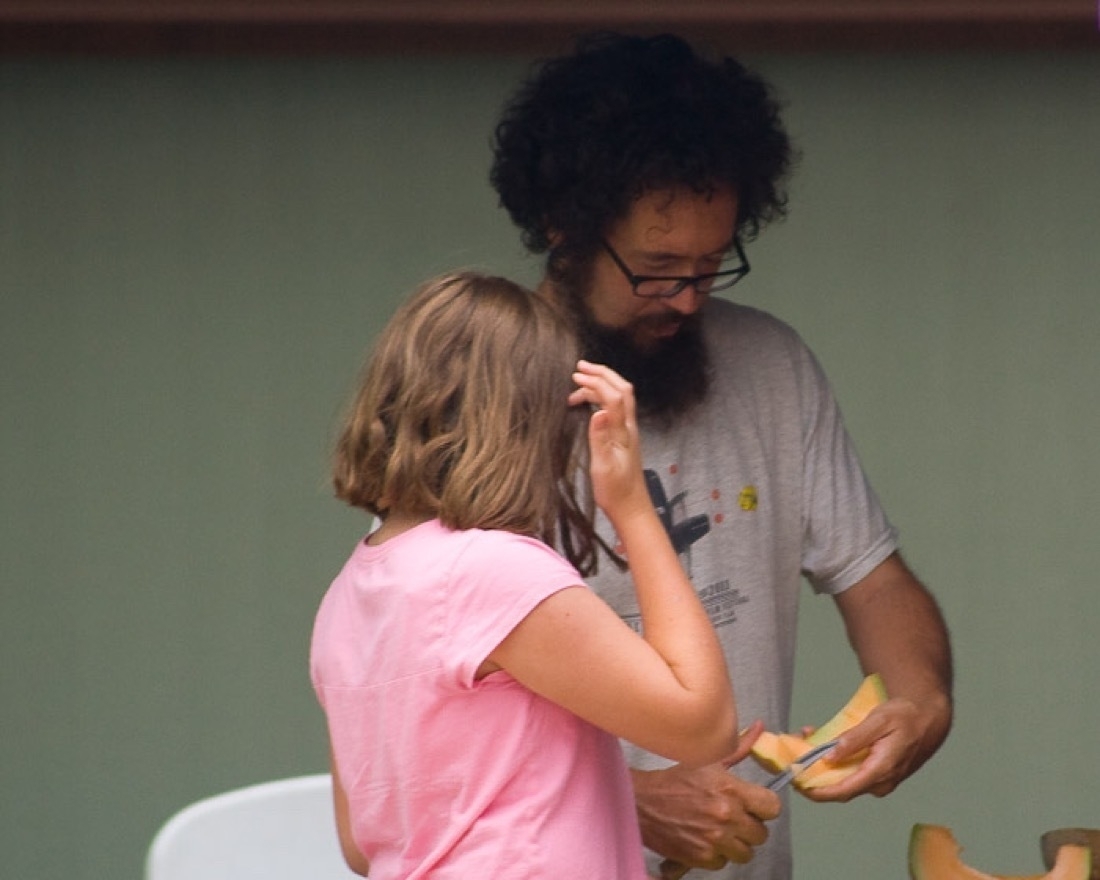 Cutting up a cantelope with my niece, Emma
Cutting up a cantelope with my niece, Emma
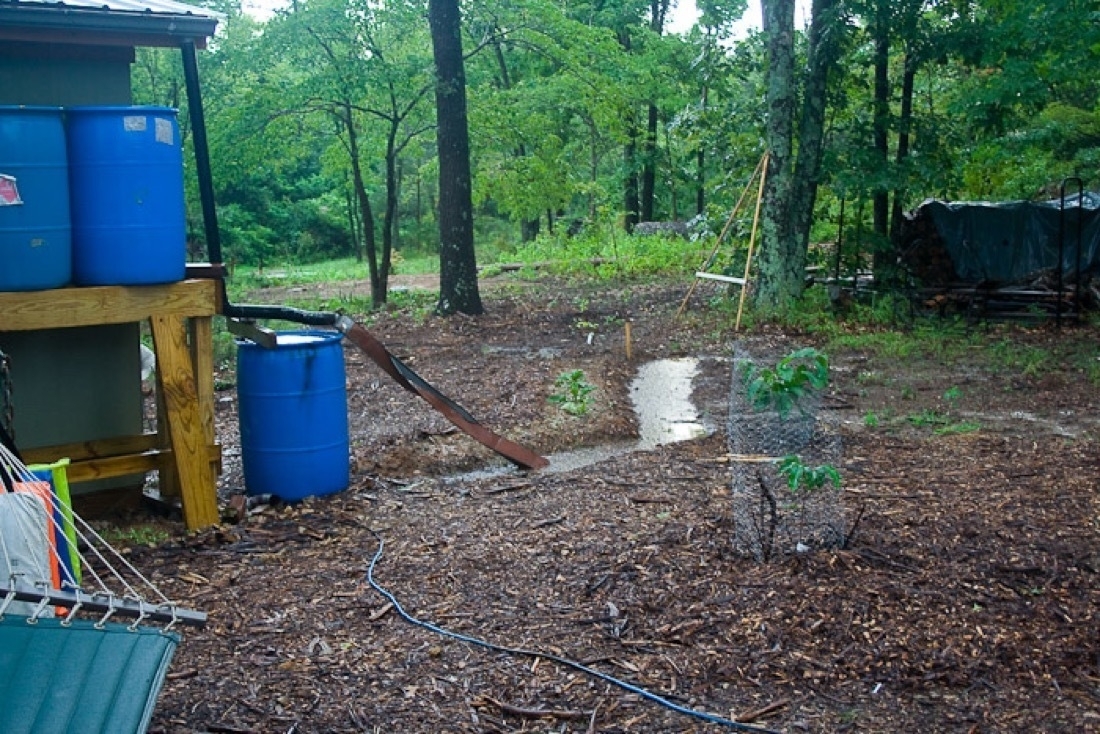 Rain barrels and swales collecting rain in the food forest behind my cabin. The system wasn’t complete when the photo was taken hence the crazy arrangement!
Rain barrels and swales collecting rain in the food forest behind my cabin. The system wasn’t complete when the photo was taken hence the crazy arrangement!
 A basket of tomatoes and basil
A basket of tomatoes and basil
With 10 days of no or little rain, full sun and high temperatures, I’m glad I’ve got all of my young fruit trees (pawpaw below) heavily mulched with cardboard, grass clippings, leaves, and branches to keep the soil cool and moist.
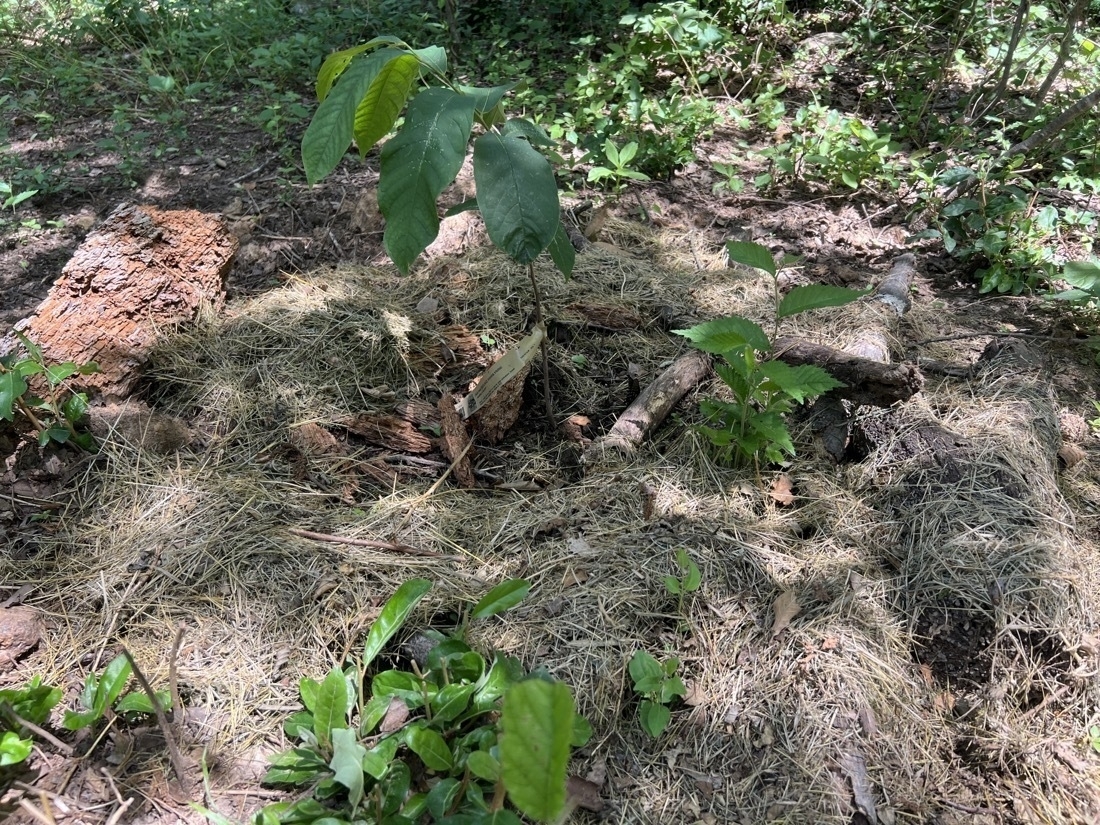
Solar Punk
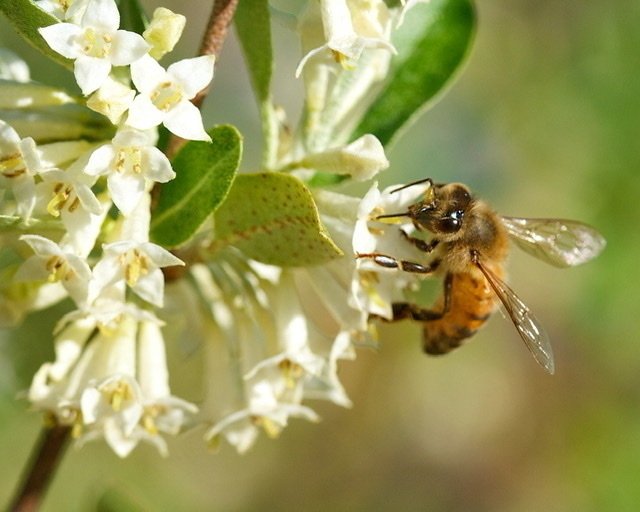 Three months ago I fell down a rabbit hole on a topic I’d heard of but never investigated: Solarpunk. And really, I’m not sure I can say exactly how I ended up there but I suspect it started when I was doing a bit of research looking for a small battery back-up and solar panel. But, in any case, it did turn up and I started looking into it and what I found is a very inspiring, interesting genre of art and fiction that sits very well with permaculture and social ecology, both of which I am very familiar with. In fact there seems to be a good deal of overlap between the three, to the point that while each comes from a different origin point and developmental history, the general destination seems to be very similar.
Three months ago I fell down a rabbit hole on a topic I’d heard of but never investigated: Solarpunk. And really, I’m not sure I can say exactly how I ended up there but I suspect it started when I was doing a bit of research looking for a small battery back-up and solar panel. But, in any case, it did turn up and I started looking into it and what I found is a very inspiring, interesting genre of art and fiction that sits very well with permaculture and social ecology, both of which I am very familiar with. In fact there seems to be a good deal of overlap between the three, to the point that while each comes from a different origin point and developmental history, the general destination seems to be very similar.
Some links...
Podcasts I’m discovering quite a few podcasts and podcast episodes. My favorite thus far is Solarpunk Now! which has, as of April 3, 2022 just gotten started with 2 episodes published and a third coming soon. Another is Solarpunk Permaculture
There are several podcasts that are not specifically Solarpunk but that that have episodes that explore it.
Beyond Species, April 27, 2020: Solarpunk Anarchism
The Fire These Times, January 7, 2022: The Political Economy of Solarpunk w/ Andrew Dana Hudson
It Could Happen Here Daily October 18, 2021: Why You Should Know About Solarpunk
General Resources
Solarpunk Manifesto at Regenerative Design Solarpunk: A Reference Guide Solarpunk: Notes toward a manifesto
More to come as I gather and edit this post…
Swales and ducklings
In June of 2015 I was living a different life not too far from my current home1. During my time there I spent a month digging a series of seven swales for water harvesting which I wrote about here. I’d also made a little video for YouTube which gets a new comment every three or four months. I had one today and thought I’d rewatch the video. There’s something very satisfying about working in a landscape, creating a new, beneficial enhancement of the ecosystem with the intent of providing for other creatures. In this case our intent was to harvest water and to provide for our ducklings. The project turned out very well. The swales harvested thousands of gallons of water and the ducklings had a place to swim.
192 Square Feet
A note about writing this. My initial intent was to post a bit about what it’s like to live in a small space but as I worked on that post it occurred to me that for my own purposes I’d like to have a more complete story of this process. I thought it would be interesting enough to offer more details is a series of posts so, I present you with part 1.
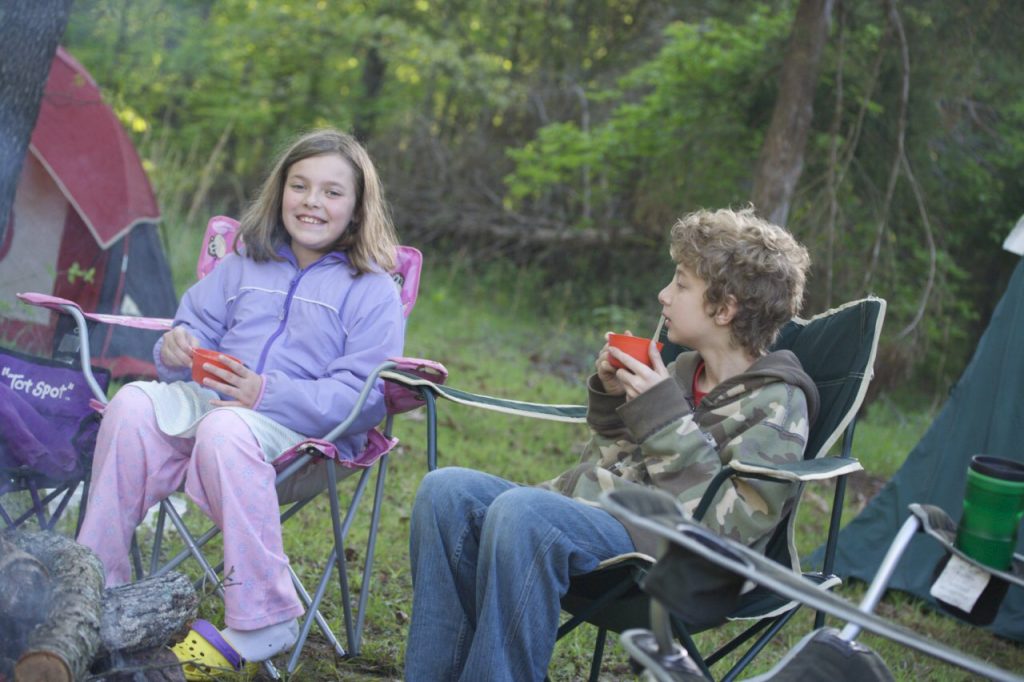 Camping during construction. My niece and nephew.
Camping during construction. My niece and nephew.
In the spring of 2008 I made a decision to begin a new living arrangement. With the economy tanking and my life in a period of transition I put thoughts of moving to Maine or Oregon on hold and decided to stay closer to my family in Missouri. With the help of my brother-in-law Greg (who is the real builder) we began a project the family had long talked about. A little village of sorts on our share of land that had been left to us by our grandparents.
Now, before I get into the story I should offer up that I am not a builder. My first recollection of building things was watching my parents help my aunt and uncle as they built a barn and house. But the adults worked, the kids played. I didn’t learn much. A few years later I remember helping my dad build our deck. I should add that my dad is also not a builder. My recollection of the process was one of frustration. My dad’s frustration as well as my own. In the end we had a very nice deck but I don’t recall it being an enjoyable or rewarding process. It may well be that I was just a bratty kid that didn’t want to spend his precious weekend helping build a deck but other memories reinforce the idea that my dad was often frustrated when trying to take on such projects. He wasn’t confident and didn’t enjoy it or at least that’s my recollection. I say this to help explain my own adult tendencies to avoid construction projects and my own lack of confidence in such endeavors. But in the spring of 2008 I did want a cabin and I wasn’t prepared to pay for one. Given that we had larger plans for multiple tiny buildings the choice to learn and work was obvious.
I knew some of the basics. Previous experience (as an adult) included replacing a part of the roof at deCleyre as well as helping a friend with a roofing job. Also, I’d helped Greg on a few renovations of their home. He had the experience and had a pretty good idea of what he was doing but I’m observant and had watched him closely. During their home renovations I’d used a nail gun, hammer, circular saw, sawzaw, jigsaw and drill. I had a pretty good idea of what it meant to build a standard 2x4 wall. I ran the electrical wiring and helped put up the drywall. I knew the building of my simple one room cabin was really just a process of building a wooden platform, four 2x4 walls, and, finally, a roof. Then all the details of adding in windows, doors, outlets, insulation, inside walls, etc. Not only did we build my cabin but we renovated a shed and built 4 other structures. At this point I don’t doubt that I could build a cabin on my own should I need or want to. Thanks Greg!
Our first building on the property was an outhouse because we knew we’d need some sort of facilities. We had that built in a weekend. It was a simple structure designed so that I could easily empty a large bucket when full. I set-up an out of the way area for a humanure compost pile which can be safely used after a couple of years .
The following weekend we set-up tents and an outdoor kitchen in an old shed. Then we spent a month (weekends only) building my 12x16 cabin. The plan for the cabin was simple. I needed something big enough to live in. I don’t own much so basically a single, multipurpose room for sleeping, working, hanging out, food storage/prep and eating. No bathroom as I planned to use the outhouse and bathing would be done outside with a solar shower and then I’d have figure something out for the winter.
Looking back on it now there are two things I would have done differently. I would have insulated my floor and I would have built it bigger to accommodate a small bathroom. If I’d gone just 4 feet more, 12 X 20 instead of 12 X 16 I’d have more room for the bathroom. But that’s it. Generally I don’t mind the lack of a bathroom but if I stay put for the long haul I’m likely to want the convenience of one. As I expected I have found that living in a small space has worked very well for me but more about that later.
We arrived to begin work on Friday night. We set-up camp and cleaned the cabin site a bit. Saturday morning we finished clearing the site of debris and started the floor platform made of treated 2x12, 2x8, and plywood. That was finished by Saturday evening. My back was already hurting.
Sunday morning started early with building the 2x4 walls. By Sunday afternoon we had the outer wall panels up. By Sunday evening we had the roof on and had the holes cut for the windows. We had a blast and had squeezed in more than 28 hours of work in 2 days and an evening. We were exhausted. We left Sunday evening after dark and I have no idea how we got home. Somehow Greg managed to stay awake while he was driving though I have no idea how.
The second weekend was adding in windows, door and electrical. I actually moved in at the end of the weekend because while it was far from finished it was a pretty weather proof shelter. It was like being in a tent except the eaves were not yet enclosed which meant flying critters got in. I woke up to a bird in the cabin one morning. There were a few flies, june bugs and other assorted winged creatures including a couple of birds that popped in one morning. There were mice. While I had my cabin ready for electric we did not yet have service hooked up so I would be using lanterns for a couple weeks. But it was home and I was happy to be in it. If that meant sharing it with a few critters well then, so be it. I was eager to get started on the garden. I had several trays of seedlings that we’re going to need a home and my garden consisted of a small field grasses and flowers.
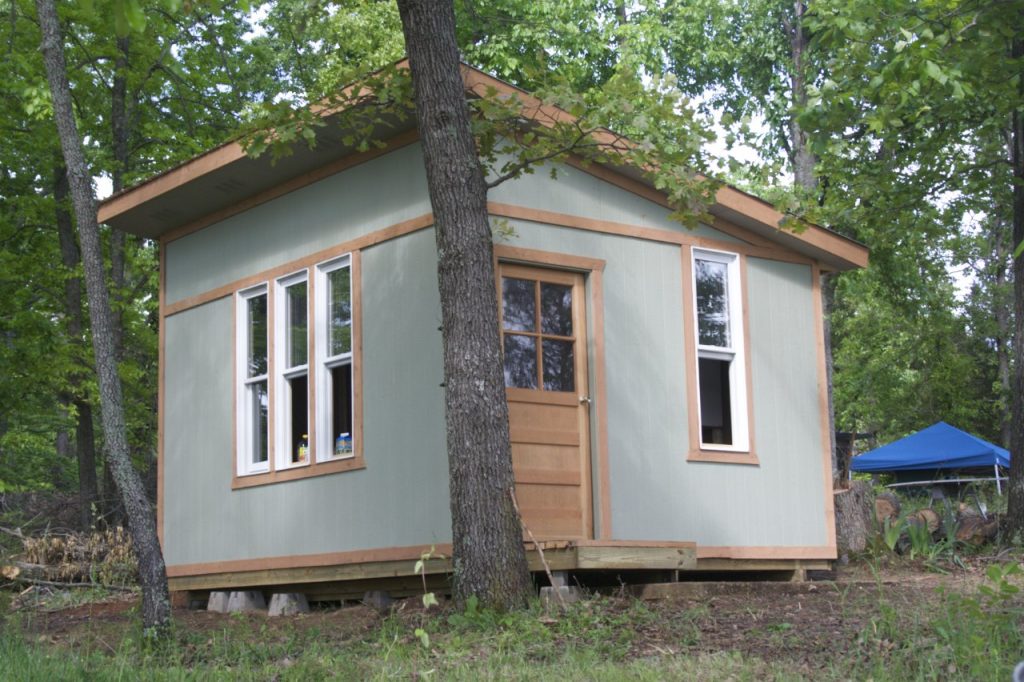 Nearly finished on the outside!
Nearly finished on the outside!
The next couple of weeks were spent alternating between gardening and building. On weekends Kerry and Greg would come with the kids and we would build while the kids played. They’d not had a whole lot of time at the lake up to this point and were just getting to the age where they could explore a wee bit. Mornings were spent around the campfire then we’d break off to work on the cabin and the kids would fish or swim with Kerry. By the last weekend of May the cabin was painted and mostly enclosed. By the end of June we’d gotten the cabin fully enclosed, the cabin painted, a ceiling fan installed and the wood slat ceiling was in place.
My weekdays were spent gardening and cleaning up the various bits of debris left from a tornado that passed through 2 years prior. I refused to use any gas tools with the exception of a chainsaw. All the darkening was accomplished with a mix of labor and time. I cleared out the garden area with a sickle and then an old fashioned non-gas reel mower. My family thought I was nuts but I put it down to idealism. It took longer to do it the way I did but it was great exercise and frankly, I enjoyed it immensely. The spring, summer and fall of 2008 might be best described as pure joy and exhaustion. In my 39 years I had never worked this hard. I’d always worked, always kept busy but never had I physically worked from sun-up to sun-down. I fell into bed each night aching and exhausted. I was gaining a whole new appreciation for what life would be like without modern conveniences, without oil.
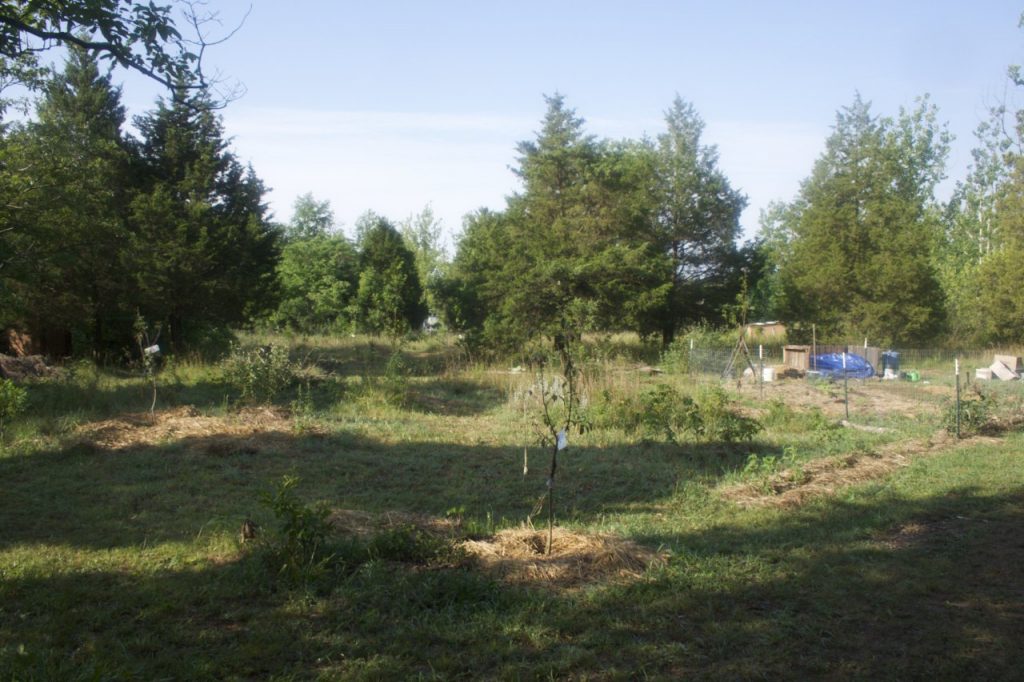 Forest garden and orchard. Fencing up, beds in, compost pile underway.
Forest garden and orchard. Fencing up, beds in, compost pile underway.
I had a small garden going by the middle of June. I considered it garden phase 1. In a month I had put up fencing, put in double-dug beds and mulched it all with cardboard and straw. Greg had begun picking up fruit trees on sale at the big box stores towards the end of June and they needed to get planted. I sickled and reel mowed pathways into a couple of areas I had planned for fruit trees. July and August will remain a blur of planting fruit trees, hauling lake water in 5 gallon buckets and weeding the garden. I’m happy to say that I didn’t loose a single tree which is saying something because these were all pretty neglected when they got here as they were sale trees that hadn’t sold at Lowes and other places. By the end of July we had a mix of peach, plum, apple, and a single pear, about 15 all together.
In mid summer Greg and Kerry found a good deal on a shed that would become the base of their cabin. We had the shed hauled from 60 miles away and added it to our budding mini-village. It’s a work in progress that continues today with plans to close in the current porch and add a new porch of recently salvaged decking.
At some point in mid summer I also began clearing out the lake front which had a downed tree covered in tall grass and flowers. There was another tornado downed tree behind my cabin and damaged trees all around the area. I gradually removed branches and cut the fallen trees down to firewood sized logs and sickled away the tall grass. Yes, this was the summer I finally became familiar with the chain saw. Previous to this I’d only ever used a chainsaw a handful of times. I was never comfortable doing it in part because I did it so infrequently. By the fall of 2008 I’d racked up many back-breaking hours with my new friend, an old red Homelight which I’m still using today. It had been my dad’s but he loaned it to me and then gifted it when he saw that I was actually using it far more than he had occasion to. It’s not the biggest chainsaw but big enough to handle small to medium tree trunks. By early October I had one or two ranks of wood chopped and ready for winter and the lake front was cleared enough that I now had a mostly unobstructed view of the lake.
Greg had come down several more times through the summer and in early August the walls had all been insulated and finished with wood paneling. As the leaves began to turn to their fall colors we put a bed and storage/guest sleeping loft followed by the wood stove. One of the last projects of the year was putting in some salvaged cabinets and a closet with some shelves and a countertop. My “kitchen”, improvised for most of the summer, started to look like a real kitchen. For much of the summer I’d used an outdoor sink set-up that functioned pretty well. But as the cold weather would be coming soon I decided it was time to move the dishwashing inside so we put in a sink though no running water. I used 3 five gallon water tanks hauled from our well house, usually just one a day. I had always been conscientious about my water use but when I was hauling all of my water by hand I can tell you I became even more careful. This was especially true in the winter when I was hauling the water 150 feet through the snow.
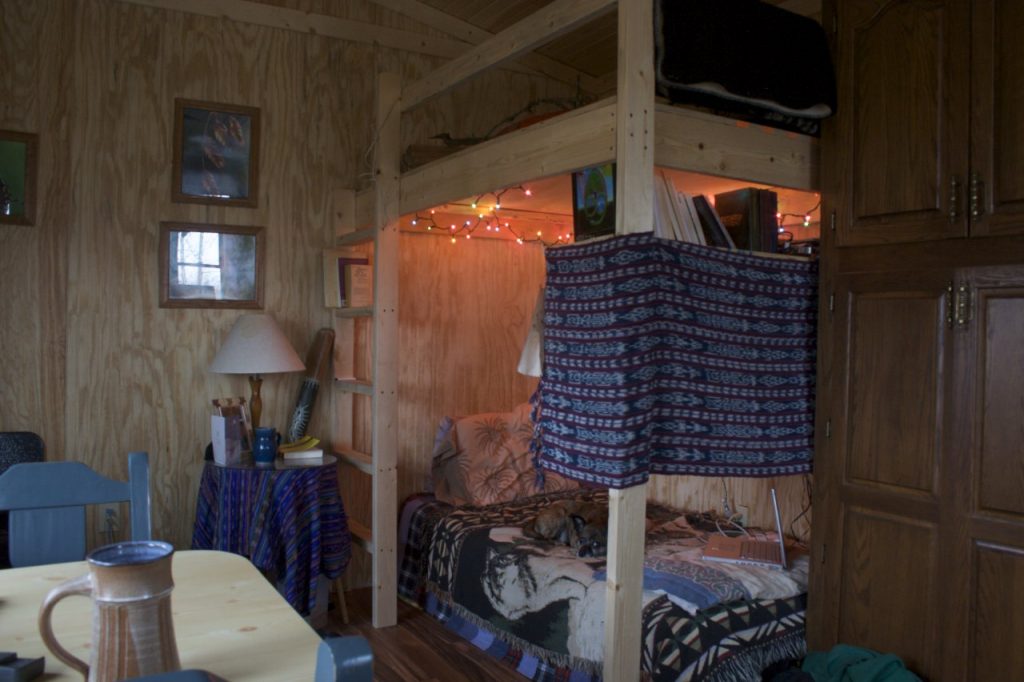 My bed, storage and guest loft above
My bed, storage and guest loft above
The summer of 2008 was busy but we were just getting started. Part 2
Spring 2016 Garden Update
Been busy gardening and made a good bit of progress in March and April getting things reestablished. Lots of natives put in for wildlife habitat as well as small food garden consisting of hugelculture beds. The kale and lettuce is looking great. Just got in a few peppers one tomatoes too. Oh, and two blueberries. Not as large as the gardens I had before but a good start at getting things going again. Depending on how my well holds up I’ll consider adding a bit more each year.
The fruit trees I put in back in 2008 are doing pretty good especially given they had little to no attention over the past three summers. Should have a nice crop of peaches, plums and pears. My three female hardy kiwi’s didn’t make it but the male did. Will need to get in some female plants if I want any fruit!
Video: Swale Update
We started putting in the swales in the middle of April so they’ve had a bit of time to mature with clover as well as a variety of edibles ranging from perennial berries to rhubarb to annuals such as kale and cow peas. As luck would have it our muscovy ducklings hatched just days after the swales filled for the first time. They wasted no time and began swimming in the swales on their first day.
Permaculture Poster One
Permaculture Progress
| Three of four planned water harvesting swales are in and partially planted. |
| The beginning of our design-a work in progress. |
The next important step was deciding to build water harvesting swales on contour on the south facing slope to the east of the house. Up until now the side yard was mostly a heavily used play area for the kids so switching it over to planted swales was an important decision. We were able to do this, in part, due to the decision to not keep goats in the future which allowed us to begin taking down the fencing which exists all over the property. Taking down the fencing means much easier access to different grassed areas for the kids to play in. The side yard is no longer a primary play area so much as a path to get to other areas further out.
| Working out the details of our plan |
We have a family of 9 living on this 5 acre property and we share it with chickens, ducks, cats, dogs and wildlife. The property itself is fairly complex with soft, fertile soil below the house, rocky soil above the house and 4 acres of woodland which includes a stream and rocky shut-ins consisting of mostly igneous rock running along the western and southern border. The land is mostly sloping with much of the slope facing south or west. In short, there's a great deal of activity and intended purpose happening here and so the permaculture dictate that observation be step one is something we've taken very seriously. We observe and discuss a great deal before taking any action and developing a plan to guide us and to serve as documentation of what has been done is important.
The plan is not done but our work is in progress. We'll proceed slowly as we co-evolve the design plan and the property at the same time. Eventually the written document will catch-up and become more of a plan for future action than a journal of what we've already done. In some aspects this has already happened as the plan has listings and placements for trees and bushes which will not arrive until next week (Pecans, Chestnuts, Goji Berries, and Lingonberries).
Progress!
Permaculture at Make-it-Do
 |
| Halfway through the dig! |
The biggest development in the kitchen garden: three new hugelculture beds built with lots of half rotted logs and ready for planting.
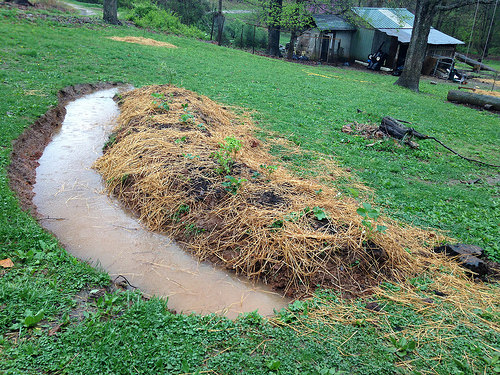 |
| Planted with fruit and filled with rain! |
Crab apple!
YouTube Channel
I set up a YouTube channel a few years ago but never made it a point to post much. A couple months back it was pointed out to me that one of my YouTube videos had gotten quite a few views, 29,000+, and that perhaps I should invest more time in developing my channel. so, this is me putting in some time creating more video updates.
The funny thing is that I actually enjoy putting them together, its just something I need to work into my routine. I'm hoping to assemble 2 - 3 each month. Here are the first two, both are gardening updates. We've been busy with baby goats, spring gardening as well as putting up a raspberry trellis and a small duck pond.
2014 Spring Garden Update
We've been making fantastic progress this spring! Thus far: potatoes, rhubarb, comfrey, goats, a new raspberry trellis and duck pond!
Bringing Permaculture to Make-It-Do
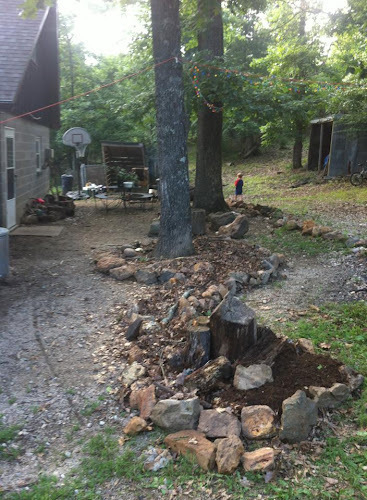 |
Hugelculture herb spiral in construction. Leaves and wood used as organic filler, topped with soil and compost. |
Let me start by saying that Permaculture is not a new concept for Kaleesha and she's been putting various elements of it into practice for several years. What is new though is having me around and my thoughts on how to go about things.
Probably the biggest change is going to be a change in goat management which is both a permaculture driven change as well as a very practical need. Essentially the goat fencing was never quite finished and with a bit of effort they were able to free-range which is not a good thing with a road nearby. Nor is it a good thing if one wants to grow berry and fruit trees and bushes or any kind of flower garden. If you dont already know, goats eat practically every kind of growing thing so growing a garden or food forest is difficult, probably impossible if goats have open access to growing areas.
Last week we finished the fencing and the goats are mostly contained. They will do their best to get past it and will find a few week points (already have!) so we'll have to get out and do a bit of troubleshooting. But as of now, it is a big improvement and they are behind the fencing most of the time which means we are now free begin landscaping areas around the house which had previously been left as grass or gravel.
After the goats the priority has been to improve the aesthetics of the north, driveway side of the house is poorly defined with two doors that confuse visitors about the actual entrance. The first door goes to the laundry room is more a utility entry but is usually the first door seen by visitors. The real entryway is not marked in anyway. That entire face of the house was used as storage with a heating unit, doors, windows and other items leaned against the wall. The rocks of the driveway were steadily migrating down into the gravel mulch that served as a yard. Most of this area is heavily shaded by the house and two large trees. The northeast side of the yard has a bit of grass and gets a good bit of sunlight.
 |
| Well rotted log from my hugelculture beds. The logs and soil are full of fungi and micro organisms. |
We started by getting all the items along the house moved to the shed. Once we cleared the space we wanted to bring some life and usefulness to the area. We built a hugelculture shade bed against the house and to the west side of the main entrance to the house. The bed has been planted with a mix of shade tolerant plants such as ferns, hostas and native columbine. A smaller bed on the other side of the door will also be built and planted with shade plants. The concrete pad in front of the door will also be getting some attention. Currently it gathers a good bit of small gravel which makes its way into the house. To help draw attention to this door as the primary entrance and to reduce the amount of gravel coming inside we are repurposing some concrete paver stones mixed with various stones found around the property which are being laid in as an extension of the pad forming a sort of patio.
Much of the focus thus far is working on moving extra plants over from my efforts at the lake. I've gotten some of the kitchen herbs and Missouri natives moved over with many more to go. My folks will be taking over my cabin and have no interest in gardening so I'm also bringing over soil from the two year old hugelculture bed. The logs are rotting up nicely and the resulting soil, previously enriched with manured straw from the chicken coop, is fantastic. Thus far the herb spiral and hugelculture beds around the mature trees in the yard have been planted with Oregano, Skullcap, Lavendar, Garlic Chives, and Purple Coneflowers.
This fall I'll move the serviceberry bushes, blackberries, and raspberries and possibly a few others. In the longterm I'd like to put the hill that the house is built on to use. It is a south-facing hill and an excellent opportunity for water harvesting with swales. Another longterm project is improving the goat forage. Currently they forage a diverse area with a fairly good mix of food but it could be improved. Yet another long term project that we'll get started in the spring of next year we will be several food forests. We'll obtain low-cost nut trees from the Missouri Department of Conservation as well as a few fruit trees from other sources.
This is a great site with fantastic potential and I look forward to becoming a part of it.
Just to let you know
A couple posts today… this first is just to let folks know that I WILL get back to permaculture/homestead related writing at some point! But the simple reality is that in the winter there’s not a whole lot going on in that area. At the moment my day-to-day routine consists primarily of reading, occasional freelance web work, starting fires and keeping them going, tending to critters, and getting the telescope out on clear nights. As we get closer to spring I’ll update a bit on the garden and food forest plans.
Pondering the Future
Specifically my personal future and also thinking a bit about this blog. I’ve obviously not been very consistent with updates. Honestly, I put some of the blame for that on Facebook. I’m sure I am not the only one who spends too much time there. While it is great for sharing I thing the downside is that much of that sharing is just reposting. I am also leery of so much content being under one roof so to speak.
So, still here. With the crazy heat and drought of this past summer my garden suffered as did the many trees and bushes I put in over the past four years. That said, almost all of my perennials survived even if they didn’t thrive. Luckily the veggie garden was, by chance, smaller. The climate future looks increasingly scary for those of us that want to eat food, wink wink.
As for my project here, it will continue for the time being though I struggle to remain enthusiastic with the annual veggies. Something about three months of intense drought and heat seems to make my garden time outside a bit less enjoyable. Our well is shallow which means I either need to haul water from the lake or invest several thousand into a new well. Climate change is ugly.
So, I’m thinking that it is time to add in a new element of activity which reflects a new interest (actually a childhood/life interest that has been sitting in a corner of my mind): astronomy! Well, science in general, but astronomy especially. While I have no intention of abandoning the permaculture work I think having another primary activity is a good thing and in the winter when growing is out I’ll have something very interesting to explore, namely, our universe.
Which brings me back to one my thoughts on the blog. I’ve not been consistent in writing about my permaculture/homestead efforts but do think I might be more consistent in reporting on my astronomical explorations as it is the sort of interest that lends itself to data collection and reporting. Should I do that here as a supplement to my other interests or do I start an astronomy based blog? Actually, I think I just sorted it out as I write. I’ll keep it here but will not just add in my astronomical observations but will also add in other science related material.
Actually, and don’t laugh, but I have this vision of humanity (or myself?) that connects to a few episodes/films from Star Trek that have always stuck with me. In particular, those which seem to showcase small, egalitarian villages in which science seems to not only co-exist with daily life, but informs a deeper and greater understanding of the relationship between humans and nature and the larger universe. Contrast this to our modern manifestation which seems to have largely become a tool for corporate profit with little regard to ethics. A great example would be GMOs and modern industrial agriculture as it might compare to a decentralized permaculture-based system informed by local and thoughtful observation.
One outlook, the modern corporate/capitalist/industrial, uses science primarily as a tool for the accumulation of wealth. The other uses science as a method for deepening our understanding of the natural world around us not just for technological development, but for the sake of understanding. In this second outlook the ethics of use would be an important part of the overall process and would include all sorts of new questions and concerns in any sort of possible application of scientific knowledge. In fact, one might say that the second view represents a kind of democratization of applied science.
Wow. I didn’t expect to take this post in this direction but it is interesting and it is something I’ve thought about off and on over the years so, yeah, I’ll be back to this at some point. Another area that I’d like to explore is science literacy and critical thought. There has been a long trend in the U.S. which seems to be gaining a bit of steam when, in fact, it should be losing steam and that is the movement against science. Such a movement can only happen when there is a lack of communication of knowledge. When people are ignorant of established scientific knowledge and the basic method which serves as its foundation there is room for manipulation.
So, you can expect that I’ll be spending some time discussing not just science but specifically science literacy. I’m not a trained scientist but I think I know enough to discuss some issues as a citizen. Specifically I’m likely to dig into the entwined relationship of politics, religion and global capitalism have been used to undermine science literacy to further their capacity as control agents: social, political, economic, ecological… everything from the genetics of corn to humans, from crowd control to the “entertainment” that comes out of the glowing screens in living rooms. Science and technology can be used in many ways for many different and often opposing agendas. I think that will be some interesting exploration.
There is also some real life stuff I’m hoping to make happen that reflects all of this, specifically a few ideas for how I might further science literacy here in rural Missouri where it is greatly needed. I’ll share that as well.
Free Range vs Pastured Chickens
Here’s a great video about the difference between “free range eggs” and pastured eggs. This is why I raise my own chickens which are, of course, pastured!
Video Tour
In celebration of my four years here at the homestead I thought I would share a little video!
Four years at the Homestead
The following spring we built the chicken coop greenhouse and in early summer we built the kids' cabin. The garden was expanded and more fruit trees were planted. The chickens arrived!! I also began work on the native wildflower Garden in front of my cabin. By the fall of 2009 I had begun to design and implement the various food forests. In addition to the fruit trees I added currants, gooseberries, paw paws, and a fairly large blueberry patch.
In May 2010 we added onto my cabin with a covered front porch and I finished my rain barrel installation. It was another hot, dry summer and I struggled to keep my garden alive. In the fall I began construction of my hugelculture beds. Another big fall project was trenching in our water line from the well house to our two main cabins. We also added onto our well house with a shower house and sleeping loft. Kerry and Greg's cabin was redesigned and the interior nearly finished.
2011 was a summer of refinements and revisions. We finished the interior of the shower house and out house. The interior if Kerry and Greg's cabin was finally finished as well. This was a laid-back summer, we swam a lot and I tried to keep the garden alive! The hugelculture beds performed fantastically.
That about sums it up. It has been a fantastic four years and this place is now my home, sweet home. I am looking forward to many more years here!
